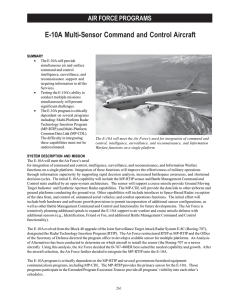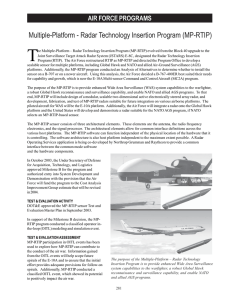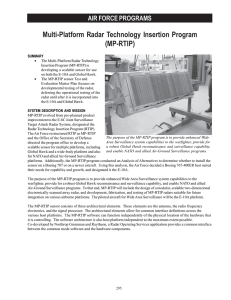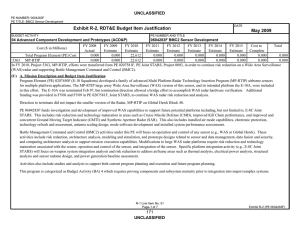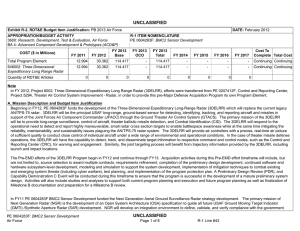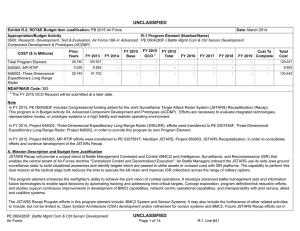T E-10A Multi-Sensor Command and Control Aircraft (MC2A) AIR FORCE PROGRAMS
advertisement
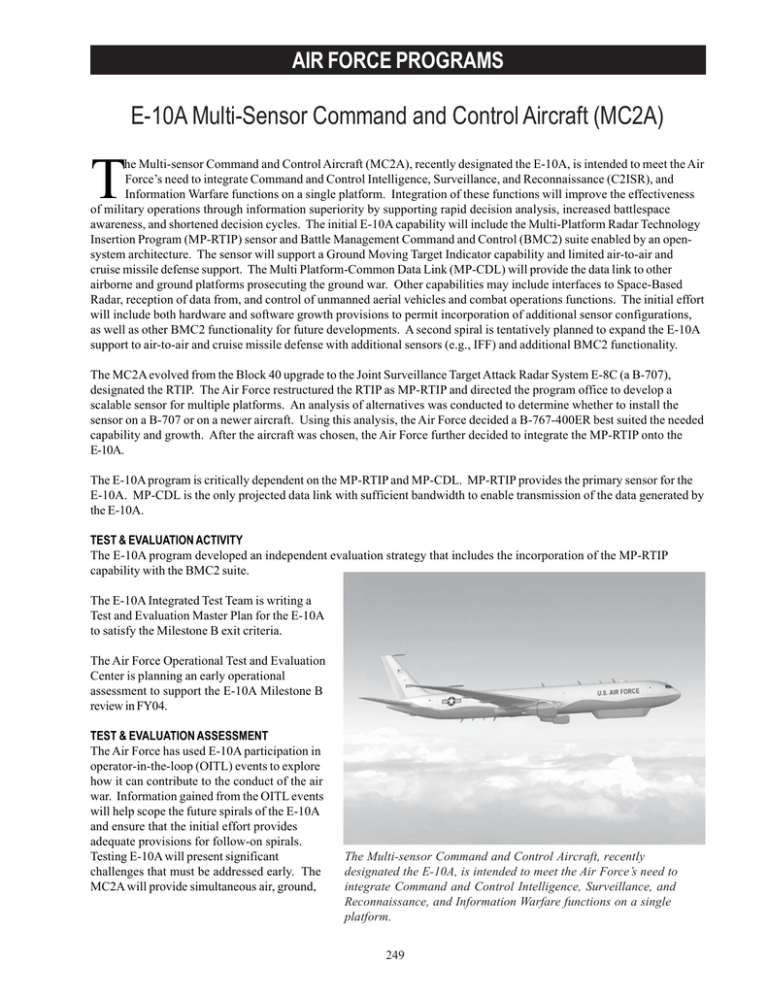
AIR FORCE PROGRAMS E-10A Multi-Sensor Command and Control Aircraft (MC2A) T he Multi-sensor Command and Control Aircraft (MC2A), recently designated the E-10A, is intended to meet the Air Force’s need to integrate Command and Control Intelligence, Surveillance, and Reconnaissance (C2ISR), and Information Warfare functions on a single platform. Integration of these functions will improve the effectiveness of military operations through information superiority by supporting rapid decision analysis, increased battlespace awareness, and shortened decision cycles. The initial E-10A capability will include the Multi-Platform Radar Technology Insertion Program (MP-RTIP) sensor and Battle Management Command and Control (BMC2) suite enabled by an opensystem architecture. The sensor will support a Ground Moving Target Indicator capability and limited air-to-air and cruise missile defense support. The Multi Platform-Common Data Link (MP-CDL) will provide the data link to other airborne and ground platforms prosecuting the ground war. Other capabilities may include interfaces to Space-Based Radar, reception of data from, and control of unmanned aerial vehicles and combat operations functions. The initial effort will include both hardware and software growth provisions to permit incorporation of additional sensor configurations, as well as other BMC2 functionality for future developments. A second spiral is tentatively planned to expand the E-10A support to air-to-air and cruise missile defense with additional sensors (e.g., IFF) and additional BMC2 functionality. The MC2A evolved from the Block 40 upgrade to the Joint Surveillance Target Attack Radar System E-8C (a B-707), designated the RTIP. The Air Force restructured the RTIP as MP-RTIP and directed the program office to develop a scalable sensor for multiple platforms. An analysis of alternatives was conducted to determine whether to install the sensor on a B-707 or on a newer aircraft. Using this analysis, the Air Force decided a B-767-400ER best suited the needed capability and growth. After the aircraft was chosen, the Air Force further decided to integrate the MP-RTIP onto the E-10A. The E-10A program is critically dependent on the MP-RTIP and MP-CDL. MP-RTIP provides the primary sensor for the E-10A. MP-CDL is the only projected data link with sufficient bandwidth to enable transmission of the data generated by the E-10A. TEST & EVALUATION ACTIVITY The E-10A program developed an independent evaluation strategy that includes the incorporation of the MP-RTIP capability with the BMC2 suite. The E-10A Integrated Test Team is writing a Test and Evaluation Master Plan for the E-10A to satisfy the Milestone B exit criteria. The Air Force Operational Test and Evaluation Center is planning an early operational assessment to support the E-10A Milestone B review in FY04. TEST & EVALUATION ASSESSMENT The Air Force has used E-10A participation in operator-in-the-loop (OITL) events to explore how it can contribute to the conduct of the air war. Information gained from the OITL events will help scope the future spirals of the E-10A and ensure that the initial effort provides adequate provisions for follow-on spirals. Testing E-10A will present significant challenges that must be addressed early. The MC2A will provide simultaneous air, ground, The Multi-sensor Command and Control Aircraft, recently designated the E-10A, is intended to meet the Air Force’s need to integrate Command and Control Intelligence, Surveillance, and Reconnaissance, and Information Warfare functions on a single platform. 249 AIR FORCE PROGRAMS and sea C2ISR support and targeting information to all the Services. It will require a high degree of joint interoperability for both ground combat and air defense. Demonstrating the ability to support the joint prosecution of the air and ground wars simultaneously will require carefully planned field tests augmented by modeling and simulation, and will demand an unprecedented level of joint cooperation. Finally, the risk associated with the interdependency of two Acquisition Category ID programs (E-10A and MP-RTIP) along with the MP-CDL must not be underestimated. E-10A is dependent on MP-RTIP to deliver its primary sensor. MP-RTIP is dependent on E-10A to provide a test platform for the sensor and the MP-CDL to serve as the pipeline for radar data to the users. Planned delivery of the three must be closely coordinated to ensure no part of the overall system has to wait for the delivery of the others. Due to the scope and the long lead-times required for these programs, such delays will significantly increase risk. 250
